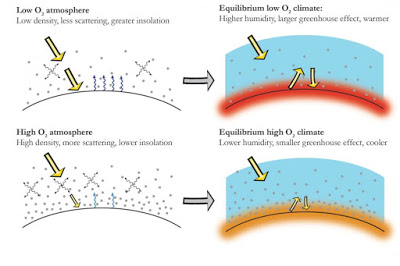
Variations in the amount of oxygen in Earth’s atmosphere significantly altered global climate throughout the planet’s history. Efforts to reconstruct past climates must include this previously overlooked factor, a new University of Michigan-led study concludes.
Oxygen currently comprises about 21 percent of Earth’s atmosphere by volume but has varied between 10 percent and 35 percent over the past 541 million years.
In periods when oxygen levels declined, the resulting drop in atmospheric density led to increased surface evaporation, which in turn led to precipitation increases and warmer temperatures, according to University of Michigan paleoclimatologist Christopher Poulsen.
“The connection between oxygen levels and climate has never been considered. It turns out that it’s an important factor over geological timescales,” said Poulsen, a professor in the Department of Earth and Environmental Sciences. While not as critical to climate as levels of heat-trapping carbon dioxide gas, oxygen plays a key role, he said.
“Oxygen concentration can help explain features in the paleoclimate record not accounted for by variations in carbon dioxide levels, and it must considered if we are to fully understand past climates,” Poulsen said. “However, variations in oxygen levels are not an important factor in present-day climate change.”
The study is scheduled for online publication in the journal Science on June 11.
Throughout Earth’s history, oxygen levels repeatedly rose and fell. Removing oxygen molecules thins the atmosphere, increasing the likelihood that incoming sunlight will make it to the surface without getting scattered away.
More sunlight means more evaporation from the surface, which leads to higher humidity levels and increased precipitation. As humidity levels rise, temperatures also increase because water vapor is a potent heat-trapping “greenhouse” gas.
Adding oxygen molecules has the opposite effect: a thicker atmosphere, more scattering of incoming sunlight, reduced surface evaporation, and less heat trapped by water vapor.
In their Science paper, Poulsen and two colleagues quantify the effect of changing oxygen levels on climate using an atmospheric global climate model to account for changes in atmospheric density, mass and molecular weights.
The team’s computer simulations focused on the mid-Cretaceous, a period characterized by high atmospheric carbon dioxide levels and the warmest conditions of the last 100 million years. Specifically, they focused on Cenomanian Age, from 100.5 million years ago to 93.9 million years ago.
They developed a series of simulations in which oxygen levels varied from a low of 5 percent to a high of 35 percent. They found that decreased oxygen levels led to substantial increases in global precipitation rates and temperature.
Changing oxygen concentrations could help explain features of the paleoclimate record not accounted for by variations in carbon dioxide levels, such as warm polar temperatures and unexpectedly high precipitation rates in some periods, the researchers conclude.
Though previously unappreciated for its influence on climate, changing atmospheric oxygen levels have long been recognized for shaping the course of life on Earth. Billions of years ago, for example, photosynthesizing cyanobacteria in the oceans released massive amounts of oxygen that eventually made it possible for animals to colonize the land.
Reference:
Christopher J. Poulsen, Clay Tabor, Joseph D. White. Long-term climate forcing by atmospheric oxygen concentrations. Science, 2015 DOI: 10.1126/science.1260670
Note: The above story is based on materials provided by University of Michigan.










